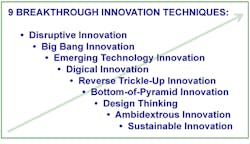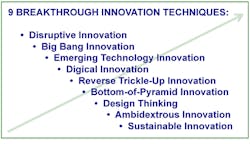Breakthrough Innovation: Nine Techniques
This file type includes high resolution graphics and schematics when applicable.
Clayton Christensen introduced “disruptive innovation” to the world in 1995. Last year, 2015, marked its 20th anniversary. Over the past two decades, many companies and makers have targeted the creation of new-to-the-world products. This has resulted in a number of approaches that are all disruptive in their own way. At this time, nine different techniques for achieving breakthrough innovation have evolved.
1. Disruptive Innovation: Clayton Christensen’s original work focuses on identifying a next-generation technology that will disrupt the existing base of products, leading to companies abandoning the older products as they move to the next-generation technology (Harvard Business Review, Jan.-Feb. 1995).
The essence of Christensen’s strategy is to be the first to market with the next generation technology in existing markets.
2. Big Bang Disruption: Larry Downes and Paul Nunes suggest that markets can be disrupted by moving away from traditional innovation models that “seek innovation in lower cost, feature-poor technologies that meet the needs of underserved customer segments” (Harvard Business Review, March 2013). They suggest that a “big bang” can be achieved by “seeking innovation through rapid-fire, low-cost experimentation on already popular platforms.”
3. Emerging Technology Innovation: Robert Phaal, et al., map out a structured "S-T-A-M" approach for taking an emerging technology still in its "science-dominated" stage and managing it through three successive stages: from “technology-dominated” to “application-dominated” to “market-dominated” (RTM, March-April 2012). The evolution of digital imaging into today’s digital cameras provides a case in point.
4. Digical Innovation: Darrel Rigby’s approach centers on “digital-physical mashups.” He believes that to consumers, the real and virtual worlds are one, and the same should go for your company (Harvard Business Review, Sept. 2014). Online versus retail shopping provides a good example. Today, one cannot physically stand in a retail store, purchase an item off the retailer’s website, and then take the item off the store shelf and head home.
5. Reverse Trickle-Up Innovation: Vijay Govindarajan and Ravi Ramamurti espouse looking for solutions that work in economically poor and developing countries, then adding selective capabilities and moving them upmarket into more established economies (IEEE Engineering Management Review, 2Q 2014). In more established economies, these products would appeal to poorer people living in the rich economy.
6. Bottom-of-Pyramid Innovation: C.K. Prahalad, recently deceased, came up with a radical approach to generate corporate wealth in the early 2000s. Rather than target affluent consumers in strong economies, why not target the millions of consumers at the bottom of the economic pyramid (Harvard Business Review, Aug. 2003)? The total wealth generated may be comparable due to the large size of the unserved market.
7. Design Thinking: Tim Brown (Harvard Business Review, June 2008), and many others since, suggest a thinking process that starts with a clean sheet of paper before the direction has been set for a product. “Along with business and technology considerations, innovation should factor in human behavior, needs, and preferences. Human-centered design thinking will capture unexpected insights and produce innovation that more precisely reflects what consumers want.”
8. Ambidextrous Innovation: Michael Tushman, et al., write that “firms thrive when senior teams embrace the tension between old and new and foster a state of constant creative conflict at the top,” and that “balancing the needs of core businesses and innovation efforts is a central leadership task” (Harvard Business Review, June 2011). They add: “When conflicts about funding old and new businesses are resolved at lower levels, innovation usually loses out.”
9. Sustainable Innovation: Green design has been practiced in many industries. Companies employing it encounter many challenges, ranging from the raw materials they use to how customers ultimately dispose of products. The financial performance of sustainable products approaches that of breakthrough products. In a sample of 12 S&P Global 100 companies, revenues from green products grew 91%, while overall sales climbed just 15% (CFO, July 2015).
Looking for parts? Go to SourceESB.
This file type includes high resolution graphics and schematics when applicable.
About the Author
Bradford Goldense
Contributing Technical Expert
Bradford L. Goldense is founder and president of Goldense Group, Inc. [GGI] (www.goldensegroupinc.com), a consulting, market research, and education firm focused on business and technology management strategies and practices for product creation, development, and commercialization. He has been an adjunct faculty member of the graduate engineering school at Tufts University's Gordon Institute for 19 years. Goldense is a Certified New Product Development Professional [NPDP], a Certified Manufacturing Engineer [CMfgE], a Certified Computer Professional [CCP], and is Certified In Production & Inventory Management [CPIM]. He holds over 200 registered copyrights and is a recognized subject-matter expert, including appearances on PBS and CNBC. He has consulted to over 250 companies and over 750 manufacturing locations on four continents since founding GGI in 1986. Goldense holds an MBA in Accounting from the Cornell Johnson School and a BSCE from Brown University. For more information, please see Brad's LinkedIn profile or visit GGI's home page.


